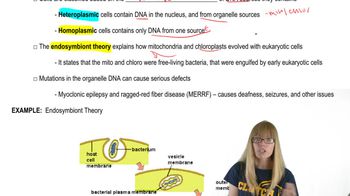Mutations in mitochondrial DNA appear to be responsible for a number of neurological disorders, including myoclonic epilepsy and ragged-red fiber disease, Leber's hereditary optic neuropathy, and Kearns-Sayre syndrome. In each case, the disease phenotype is expressed when the ratio of mutant to wild-type mitochondria exceeds a threshold peculiar to each disease, but usually in the 60 to 95 percent range.
Compared with the vast number of mitochondria in an embryo, the number of mitochondria in an ovum is relatively small. Might such an ooplasmic mitochondrial bottleneck present an opportunity for therapy or cure? Explain.
Table of contents
- 1. Introduction to Genetics51m
- 2. Mendel's Laws of Inheritance3h 37m
- 3. Extensions to Mendelian Inheritance2h 41m
- 4. Genetic Mapping and Linkage2h 28m
- 5. Genetics of Bacteria and Viruses1h 21m
- 6. Chromosomal Variation1h 48m
- 7. DNA and Chromosome Structure56m
- 8. DNA Replication1h 10m
- 9. Mitosis and Meiosis1h 34m
- 10. Transcription1h 0m
- 11. Translation58m
- 12. Gene Regulation in Prokaryotes1h 19m
- 13. Gene Regulation in Eukaryotes44m
- 14. Genetic Control of Development44m
- 15. Genomes and Genomics1h 50m
- 16. Transposable Elements47m
- 17. Mutation, Repair, and Recombination1h 6m
- 18. Molecular Genetic Tools19m
- 19. Cancer Genetics29m
- 20. Quantitative Genetics1h 26m
- 21. Population Genetics50m
- 22. Evolutionary Genetics29m
3. Extensions to Mendelian Inheritance
Organelle DNA
Problem 20
Textbook Question
Payne, B. A. et al. (2013) present evidence that a low level of heteroplasmic mtDNA exists in all tested healthy individuals.
What genetic conditions within a given mitochondrion are likely to contribute to such a variable pool of mitochondria?
 Verified step by step guidance
Verified step by step guidance1
Understand the concept of heteroplasmy: Heteroplasmy refers to the presence of more than one type of mitochondrial DNA (mtDNA) within a single cell. This can result from mutations in mtDNA, leading to a mixture of normal and mutated mtDNA molecules.
Recognize the role of mitochondrial replication and segregation: Mitochondria replicate independently of the cell cycle, and their DNA is randomly distributed during cell division. This random segregation can lead to variability in the proportion of mutated and normal mtDNA in different cells.
Consider the impact of mtDNA mutations: Mutations in mtDNA can arise due to errors in replication or damage from reactive oxygen species. These mutations can accumulate over time, contributing to the heteroplasmic pool.
Acknowledge the bottleneck effect: During the development of oocytes (egg cells), a small subset of mitochondria is selected to populate the next generation. This bottleneck effect can amplify or reduce the proportion of mutated mtDNA, leading to variability in heteroplasmy levels.
Factor in selective pressures: Certain mutations in mtDNA may confer a selective advantage or disadvantage to mitochondria, influencing their replication and survival. This can further contribute to the variability in the mitochondrial pool within a cell or individual.
 Verified video answer for a similar problem:
Verified video answer for a similar problem:This video solution was recommended by our tutors as helpful for the problem above
Video duration:
2mPlay a video:
Was this helpful?
Key Concepts
Here are the essential concepts you must grasp in order to answer the question correctly.
Heteroplasmy
Heteroplasmy refers to the presence of more than one type of mitochondrial DNA (mtDNA) within a single cell or individual. This condition can arise from mutations in mtDNA, leading to a mixture of normal and mutated genomes. The level of heteroplasmy can vary among tissues and individuals, influencing mitochondrial function and health.
Recommended video:
Guided course

Organelle DNA Characteristics
Mitochondrial DNA (mtDNA)
Mitochondrial DNA is the genetic material found in mitochondria, the energy-producing organelles in cells. Unlike nuclear DNA, mtDNA is inherited maternally and is circular in structure. Variations in mtDNA can affect cellular energy production and are linked to various genetic disorders, making its study crucial in understanding mitochondrial function and disease.
Recommended video:
Guided course

Organelle DNA Characteristics
Mitochondrial Dynamics
Mitochondrial dynamics encompass the processes of mitochondrial fusion and fission, which regulate the shape, size, and number of mitochondria within a cell. These processes are essential for maintaining mitochondrial function, quality control, and distribution during cell division. Variations in these dynamics can lead to a heterogeneous population of mitochondria, contributing to the observed heteroplasmy.
Recommended video:
Guided course

Organelle Inheritance

 4:11m
4:11mWatch next
Master Organelle DNA Characteristics with a bite sized video explanation from Kylia
Start learningRelated Videos
Related Practice
Textbook Question
690
views
